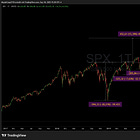Yesterday evening I dropped a FREE post about the current window of risk call, investigating the story that the market is telling us, explaining the underlying dynamics:
Supportive OpEx/suppressive OpEx?
Supportive vanna&charm flows and so on…
Is it really this simple?
If something is supportive is suppressive is very much context dependent, and assuming flows by using only the OTM “skew” contracts for schematic examples is not necessarily accurate.
The supportive/suppressive is coming from the passive flows. But passive flows can be overwritten/interfered by shadow greek generated flows, and also the net exposure on a short or long speed profile is not a straight indicator to judge the vanna and charm flows because their weights can be different over the chain and tenors, generating different impacts.
I tell you an example:
A negative speed profile would look like this using the schematic modelling of skew contracts: MM is net long OTM puts and net short OTM calls.
Result? Net positive charm (because OTM put has positive charm, and OTM call has negative charm, but he shorts the OTM call, so his exposure is positive charm on this call as well) and net negative vanna (same reason).
…even tho vanna cannot be handled this way…
Is it really suppressive?
If vol is sold, negative vanna would make the dealer longer delta, making him sell futures, and vice versa, while as the time passes the long charm makes him longer delta too adding another layer to sell futs.
This simple positioning could be called right-tailish in itself, that is literally sells the left-tail of the curve (depending on the convexity, but here I take only this schematic exposure). So, while it tends to generate liquidity to the downside it also prevets downside vol squeezes while opens the gate for upward gamma squeezes.
But where is the centroid of this setup that activate one or the other scenario? How vanna, gamma, etc. interfere with time and volatility?
What if the dealer doesn’t simply have these two contracts but thousands, if not millions, with different expos and different sizes?
How will the exposure change then? What shape the distribution will have?
Now… these are the questions that these oversimplified OpEx explainations doesn’t give you.
I’m able to code these. In this post, I share the outputs of the models and shortly explain the coded effective interactions.


